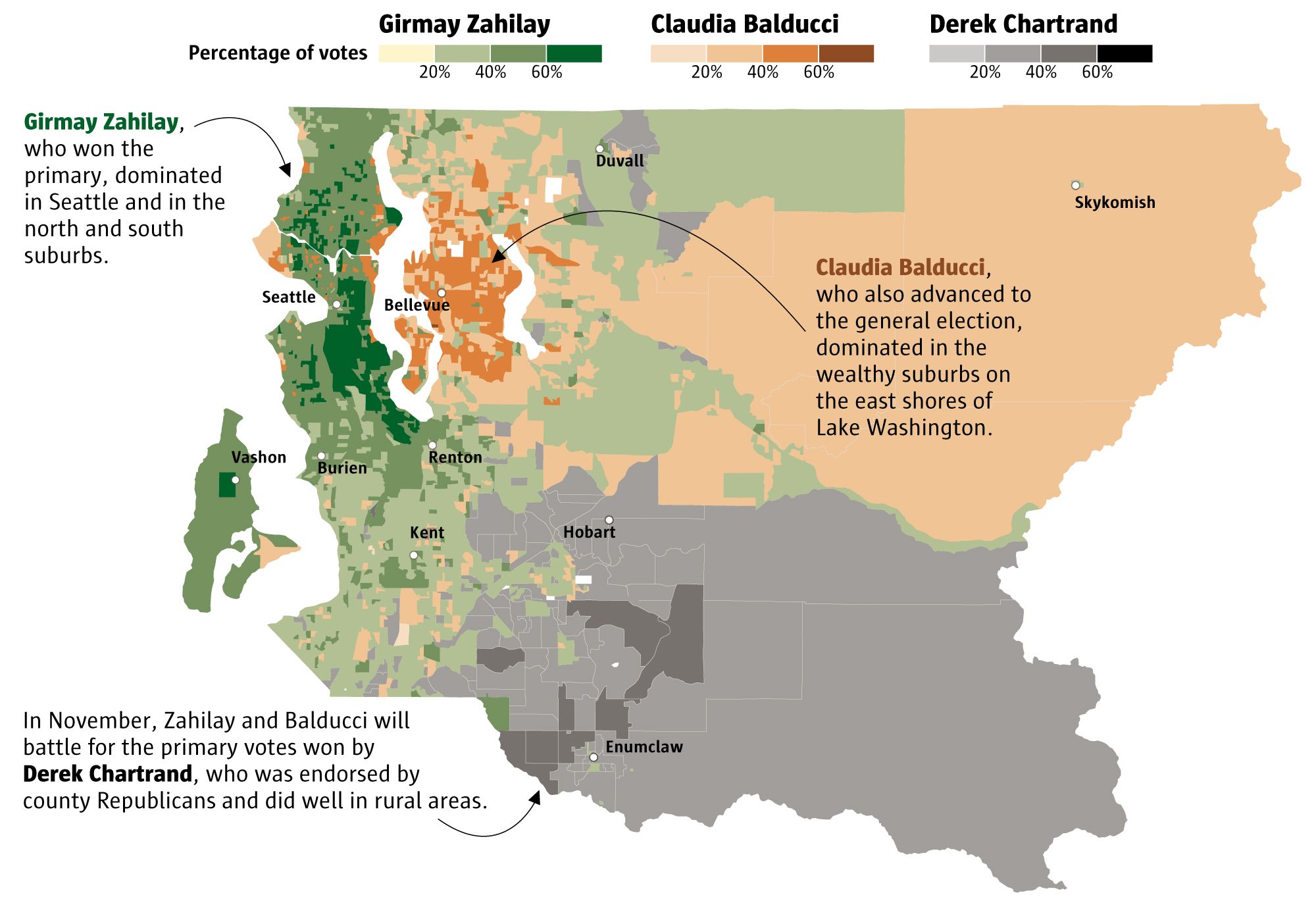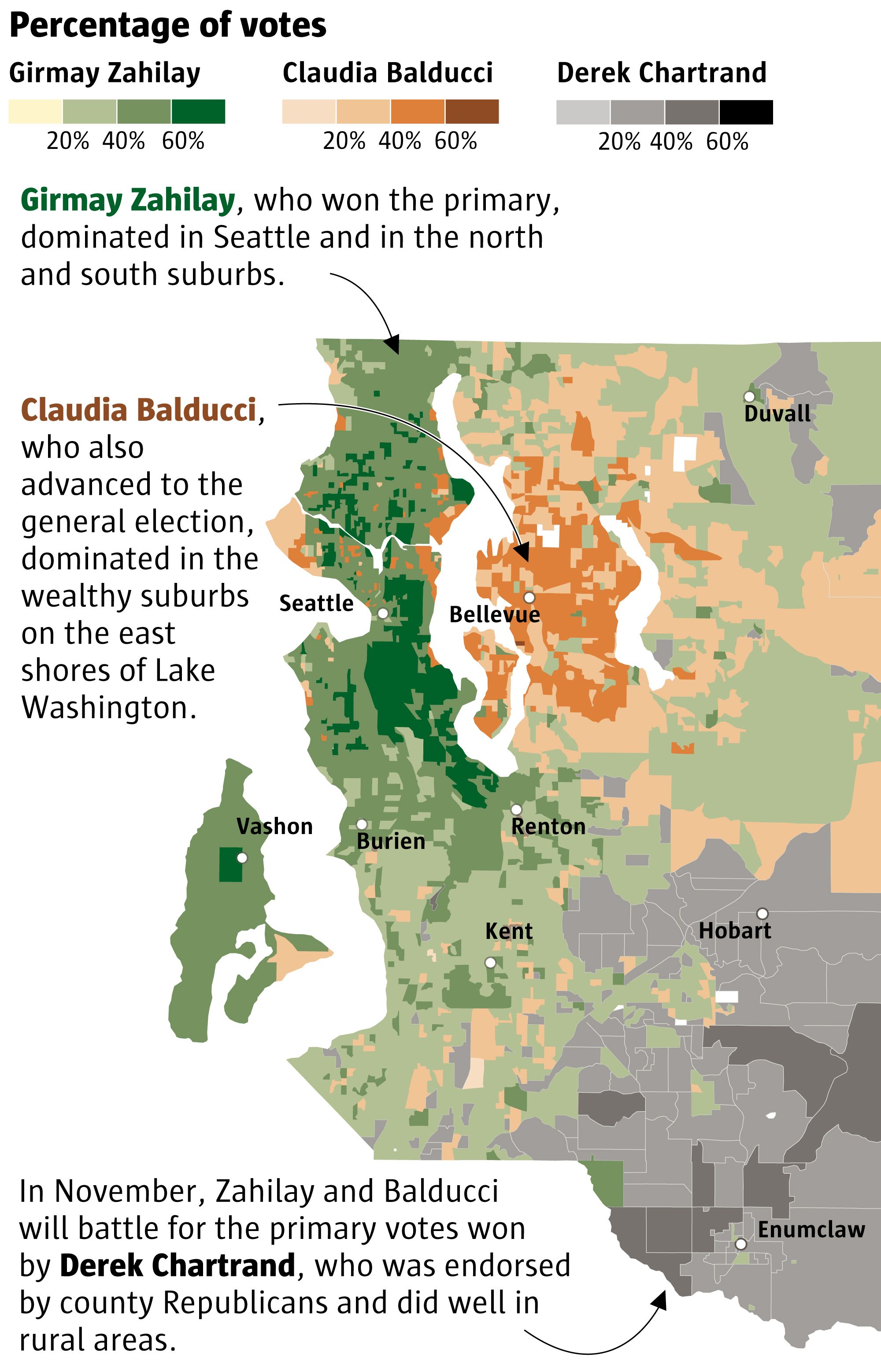King County’s political landscape is influenced by geography, with clear voting patterns emerging along distinct geographical divides. Understanding these patterns can provide valuable insights for Kirkland residents, business owners, and anyone interested in local politics. In this guide, we’ll explore how geographic factors shaped the recent King County executive primary election between Girmay Zahilay and Claudia Balducci, and what these patterns tell us about our communities.
If you’re a longtime resident curious about your neighborhood’s political leanings or a newcomer trying to understand King County’s diverse political geography, this how-to guide will help you interpret the interesting geographic dimensions of voter preferences across our region. By examining precinct-level data and neighborhood-specific trends, we’ll reveal how location influences political outcomes and what this might mean for future elections.

- Map illustrating Zahilay’s strength west of Lake Washington versus Balducci’s dominance in Eastside communities. Source: @davidlgutman – seattletimes.com
How to Analyze the East-West Divide in King County Voting Patterns
To understand King County’s voting geography, visualize Lake Washington as a natural dividing line between two distinct voting blocs. This east-west split was demonstrated in the recent primary election for County Executive, with Metropolitan King County Councilmember Girmay Zahilay dominating west of the lake while County Councilmember Claudia Balducci showed strength to the east. This geographical divide isn’t just arbitrary—it reflects long-standing differences in community priorities, demographics, and representation histories that have developed over decades.
When examining precinct-level data, you’ll notice Zahilay’s performance in Seattle (winning 92% of the city’s precincts), Shoreline, and Vashon Island, as well as in South King County communities like Burien, Tukwila, and Skyway. Meanwhile, Balducci demonstrated significant strength in Eastside communities, winning 93% of precincts in Bellevue and performing well in other lakeside suburbs like Kirkland, Mercer Island, and Redmond. This geographical voting pattern remained consistent throughout the primary, with few exceptions to this east-west division, highlighting how location often serves as a stronger predictor of voting behavior than other factors.

- Detailed results showcasing Zahilay’s dominance in Seattle and South King County, and Balducci’s win rate in Bellevue. Source: @davidlgutman – seattletimes.com
How to Interpret Neighborhood-Specific Voting Trends
When analyzing neighborhood-specific voting trends, look closely at each candidate’s strongholds to understand their base of support. Zahilay’s impressive 92% win rate in Seattle precincts provided him with a substantial lead of about 50,000 votes from the city alone. Unlike other progressive candidates who typically split Seattle with more moderate opponents, Zahilay won across all Seattle neighborhoods—from North Seattle to the downtown core, West Seattle, and especially South Seattle, where he won every precinct but one. His dominance extended to South King County, including areas where he grew up (Skyway) and currently lives (Tukwila).
Balducci’s strength was concentrated in the affluent Eastside communities, particularly in Bellevue, where she has deep political root,s having served as mayor and on the City Council. Her 93% win rate in Bellevue precincts demonstrates how neighborhood representation history significantly influences voting patterns. When examining neighborhood data, notice how both candidates performed best in areas they represent on the County Council, showing that voters tend to support candidates with whom they have established relationships. This pattern suggests that in King County, geographic representation often transcends ideological differences, as Zahilay won in both progressive and moderate Seattle neighborhoods that have historically supported different types of candidates.
How to Forecast General Election Outcomes Based on Geographic Patterns
To forecast the November general election outcome, start by analyzing where both candidates need to expand their support to reach the crucial 50% threshold. Zahilay enters the general election as the frontrunner with 44% of the primary vote compared to Balducci’s 30%, but neither candidate can coast to victory. The approximately 20% of voters who supported other candidates—particularly those who backed Republican-endorsed Derek Chartrand and moderate Democrat John Wilson—will likely determine the winner. Pay special attention to the conservative rural southeast portion of King County, including unincorporated areas and small cities like Enumclaw and Black Diamond, where neither frontrunner performed strongly.
When developing your forecast, consider historical voting patterns in similar situations. Typically, when King County voters face two Democratic options, a significant number of Republican voters sit out the race entirely. Balducci’s campaign has indicated she’ll target these more conservative voters, while Zahilay’s team has questioned whether either candidate can successfully appeal to Republican voters without alienating their core Democratic supporters. The key question is whether either candidate can convince these voters to participate rather than abstain. Based on past elections with similar dynamics, many analysts believe Balducci might gain more support from these voters, but they would need to turn out in overwhelming numbers and strongly prefer her to have a significant impact on the outcome.
Header Image Source: AI-generated image
